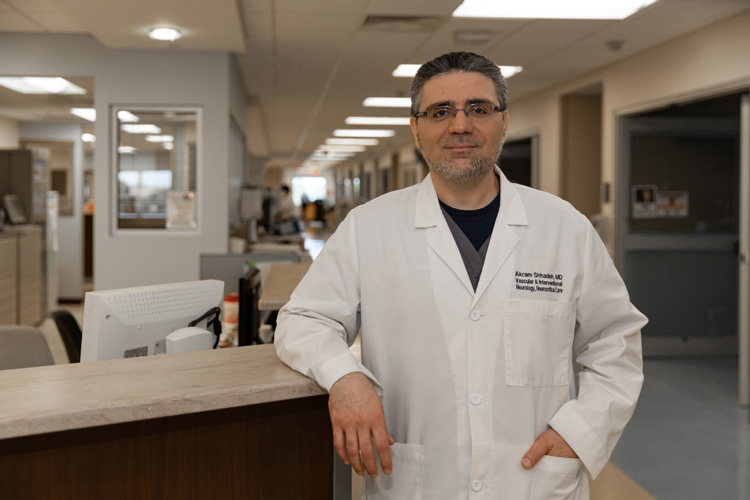
About 75 percent of strokes in this country occur in people 65 or older. That makes Vero Beach with its older demographic a ‘ground zero’ for these debilitating and often deadly medical emergencies.
“I can tell you on average we get eight to 15 stroke alerts every day,” says Dr. Akram Shhadeh of the Arubah Neuroscience Institute, now one of the leaders of the Indian River Medical Center’s stroke team.
As Vero’s winter residents flow back into town, he warns: “Here’s the bad news: It’s the holiday season now. [Those numbers] will go up.”
Strokes occur when blood vessels inside the brain are blocked by a clot (ischemic strokes) or when blood vessels rupture inside the brain (hemorrhagic strokes), disrupting the proper flow of blood to brain cells. Either scenario can be lethal.
The Centers for Disease Control says “stroke kills about 140,000 Americans each year. That’s one out of every 20 deaths. Someone in the United States has a stroke every 40 seconds. Every four minutes, someone dies of stroke.”
That’s why the Indian River Medical Center turned its eyes south and lured neuro-interventionists Shhadeh, Dr. Vikas Gupta and Dr. Ayman Gheith to Vero Beach.
Pioneers in an impressively successful surgical approach to treating ischemic strokes – which constitute roughly 87 percent of all stokes nationwide, according to the CDC – the Arubah Neuroscience team has now brought its ‘mechanical thrombectomy’ procedure to Indian River County.
As the Oregon Health and Science University’s Brain Institute explains, “if you have an ischemic stroke, certain doctors can do a procedure called a thrombectomy to remove the clot.
“The doctor threads a catheter through an artery in your groin up to your brain. Once the catheter is in place, the doctor uses a tiny mechanical device to break up or remove the clot.”
Not only is this a potentially life-saving procedure but at the International Stroke Conference in Los Angeles this past January, researchers determined “a thrombectomy can double a patient’s chances of avoiding disability after a stroke,” even if the procedure is done as much as 24 hours after stroke symptoms present.
But there is a catch. Not just any hospital and not just any doctor can perform this procedure.
It takes a team, and Shhadeh says he, Gupta and Gheith “are a comprehensive team. We deal with very high-risk situations and patients, and we need a lot of resources in place and a lot of other team members from different departments to work collaboratively. And you need one leader for the team that orchestrates everything.
“That’s what attracted us to Indian River Medical Center. Every single one we met and dealt with and negotiated with had a genuine interest in improving patient care in this institution and in this area.”
Indeed, Shhadeh and his colleagues have their sights set on nothing less than delivering an elite “comprehensive stroke center” designation for IRMC, awarded by JCAHO – the Joint Commission on Accreditation of Healthcare Organizations.
While IRMC already has a JCAHO “primary stroke center” designation, there are some 1500 of those nationwide, while fewer than 200 facilities have been certified as “comprehensive stroke centers.”
Shhadeh points out that “JCAHO accreditation holds us to a much higher standard” than those set by individual states. “We have all the pieces in place. If you just look at the data and the capability, we are already comprehensive, but [the actual] paperwork needs a year or two to get through.”
One of those pieces already in place, Shhadeh says, is what he calls “a biplane room.”
A biplane room is a specially designed hybrid operating suite with a neuroangiography machine. A significant advancement for the diagnosis and treatment of strokes, the neuroangiography equipment provides highly detailed three-dimensional views of the blood vessels leading into the brain as well as those deep inside the brain, making interventional surgeries possible.
As the conversation continues, IRMC nurse practitioner Brianna Parker hands Shhadeh a phone. On its screen are high-resolution images of a stroke patient’s brain scans performed just moments earlier. In this instance, and at other times, Shhadeh is able to almost instantly diagnose the situation and relay instructions directly to his colleagues from wherever he is.
Without a hint of self-aggrandizement, Shhadeh concludes by saying, “what we’ve achieved here took us only 10 percent of the time that it took us at [Arubah Neuroscience Institute’s previous hospital] because there was a clear vision from leadership here and from all the teams involved. This is what they want. They want to do whatever it takes to help the community here.”
For information on the signs of a stroke, go to www.strokeassociation.org.
If you or a loved one should experience any of those symptoms, Shhadeh says the best thing to do is to call 911 immediately.
Dr. Shhadeh is with the Arubah Neuroscience Institute at Indian River Medical Center. His office is at 3450 11th Court in Vero Beach. The phone number is 772-448-8600.



